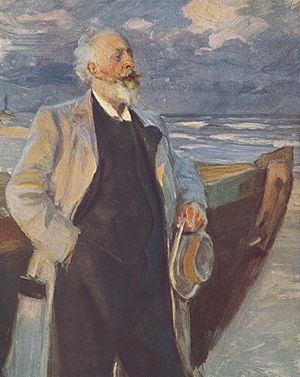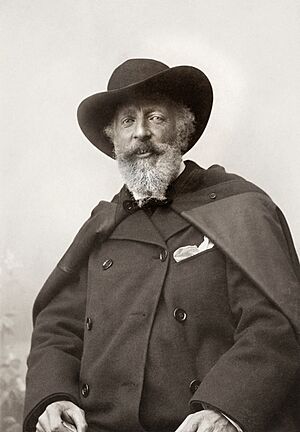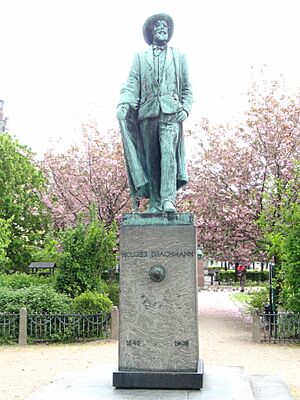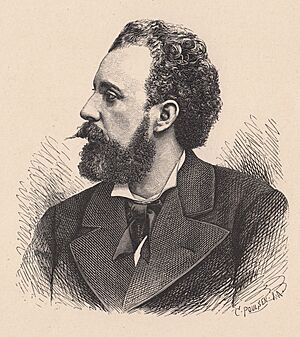Holger Drachmann facts for kids
Holger Henrik Herholdt Drachmann (born October 9, 1846 – died January 14, 1908) was a famous Danish poet, writer for plays (dramatist), and painter. He was part of the group of artists known as the Skagen Painters. He also became an important person in the Modern Breakthrough movement in Scandinavia, which was a time of new ideas in art and literature.
Contents
Early Life and Interests
Holger Drachmann was born in Copenhagen, Denmark. His father, Andreas Georg Drachmann, was a surgeon for the Royal Danish Navy. Holger's mother, Wilhelmine Marie Stæhr, passed away when he was young. Because of this, he often had to entertain himself. He loved to create imaginary adventures and games with his friends. In these games, he would often pretend to be famous Danish naval heroes like Peder Tordenskjold and Niels Juel. This early love for stories and heroes later showed up in his writing.
Life in Skagen
Drachmann first visited Skagen, a town at the northern tip of Denmark, in 1872 with a Norwegian painter named Frits Thaulow. He liked Skagen so much that he came back many times. He joined a growing group of artists there, known as the Skagen Painters. Even though he painted, his writing became more important to him. In 1903, he and his third wife, Soffi, made their home in Skagen at a house they called Villa Pax. Later in his life, Drachmann returned to painting, often creating pictures of ships and the sea.
Personal Life and Inspirations
Holger Drachmann traveled to Bornholm to study painting. There, he met Vilhelmine Erichsen, who became his first wife in 1871. They had one daughter named Eva. Later, his marriage ended. He had several important relationships throughout his life. He married Vilhelmine Erichsen and later Emmy. He had children and adopted one daughter. He found inspiration from many women, whom he called his "muses." Two of his most important muses were Vilhelmine and a woman he called Edith.
Holger Drachmann passed away in Copenhagen. He is buried in the sand dunes at Grenen, which is close to Skagen. After he died, his home in Skagen, called Drachmanns Hus, was turned into a museum.
His Career as an Artist and Writer

Holger Drachmann started university in 1865 but left in 1866 to study art at the Royal Danish Academy of Fine Arts. From 1866 to 1870, he learned to paint marine scenes (pictures of the sea and ships) and became quite good at it. Around 1870, he met a Danish writer and critic named Georg Brandes. This meeting inspired Drachmann to spend more time on writing, though he never completely stopped painting.
He traveled a lot to places like England, Scotland, France, Spain, and Italy. He would send letters about his journeys to Danish newspapers, which helped start his writing career. When he returned to Denmark, he lived for a while on the island of Bornholm, where he painted seascapes.
In 1872, he published his first book of poems called Digte (Poems). He joined a group of young, forward-thinking writers who followed Georg Brandes. Drachmann was always exploring new ideas and wasn't sure if he was better at painting or writing. He had many experiences, especially with sailors, fishermen, students, and artists. Events like the Franco-German War and the Paris Commune made him feel that a new and exciting time was coming.
His book of poems, Dæmpede Melodier (Muffled Melodies), published in 1875, showed that he was a very talented poet. He then quickly started writing many books in both prose (regular writing) and verse (poetry). Some of his famous works include Sange ved Havet; Venezia (Songs of the Sea; Venice, 1877), which was greatly admired. He also wrote Derovre fra grænsen (Over the Frontier there, 1877), which shared his thoughts after visiting the places of the war with Germany.
Drachmann traveled to many countries, learning a lot about the sea and the lives of people who live by it. In 1879, he published Ranker og Roser (Tendrils and Roses), which contained beautiful love poems. He also wrote Paa sømands tro og love (On the Faith and Honor of a Sailor, 1878), a collection of short stories.
Around this time, Drachmann changed his views and became a leader in a more nationalistic movement in Denmark. He continued to write about the lives of fishermen and sailors in popular books like Paul og Virginie and Lars Kruse (both 1879), and Strandby Folk (1883). In the early 1890s, he again connected with the ideas of Brandes, but he still kept his national themes. His changing ideas were likely due to his constant excitement and desire to find a strong foundation for his art.
In 1882, Drachmann published his excellent translation of Byron's Don Juan. In 1885, his romantic play Der var engang (Once upon a Time) was very successful at the Royal Danish Theatre in Copenhagen and is still a classic today. His plays Vølund Smed (Wayland the Smith, 1894) and Brav-karl (1897) made him Denmark's most popular playwright. In 1894, he published Melodramas, a collection of fantastic rhymed poems that many consider some of his best work.
His novel Med den brede Pensel (With a Broad Brush, 1887) was followed by Forskrevet (1890), a story about a young painter named Henrik Gerhard. This novel explored his character's struggle against his everyday surroundings. Den hellige Ild (The Sacred Fire, 1899) was closely related to this novel, where Drachmann shared his own thoughts and feelings. This book was like an autobiography, full of poetic parts. In 1899, he wrote the romantic play Gurre; in 1900, a brilliant poetic play called Hallfred Vandraadeskjald; and in 1903, Det grønne Haab.
His Legacy
Holger Drachmann is one of the most beloved Danish poets of modern times, even though some of his works are not as well-known today. He combined new, rebellious ideas with a romantic view of women and history. His lively personality often seemed as famous as his writing. He was seen as a "typical" bohemian poet, living a life full of changes. His relationships with different women, his "muses," often caused a stir, but they were a big source of inspiration for his art. Especially "Edith," a cabaret singer who was his partner in the 1890s, inspired many of his best love poems.
See also
 In Spanish: Holger Henrik Herholdt Drachmann para niños
In Spanish: Holger Henrik Herholdt Drachmann para niños





